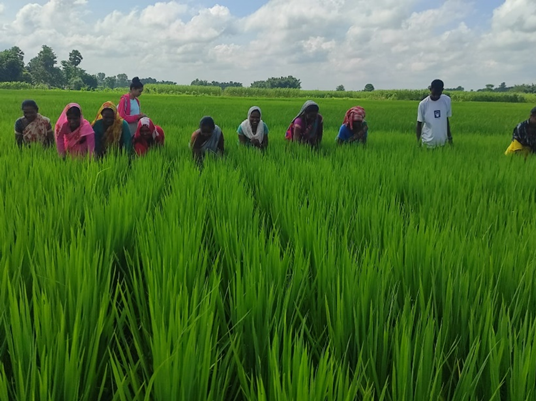
Seeing (and Doing) is Believing
A more-efficient, more-productive method of planting rice called System of Rice Intensification (SRI) sounds like hocus-pocus to prospective users at first. “You use less water, your costs are reduced, but your yields are greater? Hmmmph. Do I look like I was born yesterday?” Yet it never fails to impress long-time rice farmers once they see the results.
Fifty-four women and six men representing three farmers groups recently received two days of SRI training two weeks apart from local partner Group of Helping Hands (SAHAS) Nepal. The instruction also included information on rice pests, disease control and other preventive measures.
The first session covered the benefits of SRI, land & nursery bed preparation using composted manure as fertilizer, and planting the seeds to produce seedlings for transplanting in the second session. Two weeks later, participants worked together preparing two demonstration plots. One they planted in the traditional manner, crowding seedlings in the space. The other they marked off carefully into 8” x 8” squares, using a length of rope for measurement. They planted only one seedling in each square as instructed, though they were sure these seedlings would die.
The traditional plot was flooded; the SRI plot would receive intermittent irrigation instead. The SRI plot needed weeding, either by hand or with a simple mechanical weeder. The farmer groups contributed equally to the care and maintenance of the plots. During the growing period, the participants were able to see with their own eyes that the SRI plot needed less seed, water and fertilizer. And because each seedling generated ten additional seedlings, the yield was greater than with the traditional field. All this translates to less investment for greater harvests, a definite win for the farmers.
One participant said, “We never believed that planting a single seedling would create a big bunch, until we saw it growing so well. Also, we saw less rodent damage. We analyzed costs, and saw that, though we did have to spend time weeding, our expenditures were reduced but our yields were improved. We will plant bigger plots next year using SRI.”
Nepal Jahada Program
Led by Mennonite Central Committee and Local Partner Group of Helping Hands (SAHAS) Nepal
